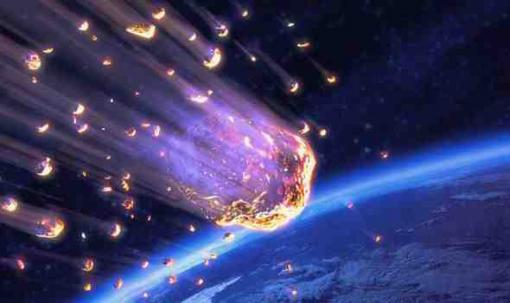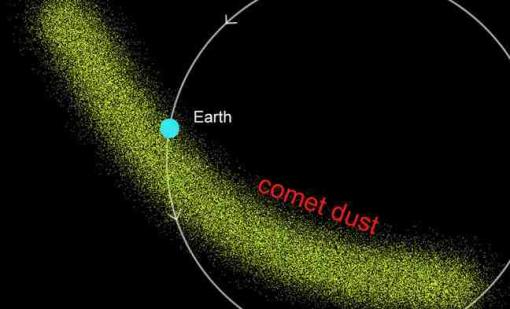Meteor showers (Arabic: المطر الشهابي or الزخات الشهابية) are an interesting phenomenon in which meteors (Arabic: شهب) --a.k.a. shooting stars or falling stars--crease the numbers they fall with. Some think it looks like a shower but it doesn't except extremely rarely and if you're lucky and looking at the right spot at the right time. It may for a second look like Cosmic fireworks in the sky like we were told by our friends in Katrina town, Sinai where sky is always very clear. But again that's EXTREMELY rare.

First What's a Meteor
There are small rocks (the size of Cairo or smaller like the size of Nasr City and sometimes the size of little room) that are roaming space all the time around our planet. When a rock comes into the range of gravity of Earth they are attracted and go to crash into it with exceeding speed (70 km per second is normal) penetrating the atmosphere before they hit the ground. At atmosphere they get resisted by the air which makes it increasingly hot until it starts melting the rock itself. Not only melting but even to temperature of evaporation of the minerals/metals of the rock itself. In this stage of firey 'glow' it leaves a trail of glowing material behind it until nothing is left at the core and it all evaporates into a quick glowing line in the sky that fades very quickly depending on the amount of rock and heat.
In very few cases, part of the core is so large it may not be consumed quickly enough and this piece of melting rock hits the ground causing a 'crater' with characteristics to it that scientists can identify.
The moon is covered by zillion craters showing that every meteor has hit it (it has no atmosphere), and even in Egyptian desert we can observe many craters in many sizes.
So What's a Meteor "Shower"
Earth receives meteors every night for millions of years. But meteor showers happen because some known rocks areas in space are coming near our planet and stars falling into it.
As you can see in the pics below, some are in belts of large group of rocks in the space in which Earth's orbit overlaps with it, so whatever falls in the grip of Earth's gravity is sunken to its surface as meteors. Sometimes they come one piece at a time (sparsely distributed) but if they look like the group in the second pic together (rare in space because all distances are 'astronomical') then you find the very rare fireworks.
And because of the fixed place of those belts and earth's orbit around the sun, they can have predicted time and that's why we have the calendar below

Meteor Storms
Those rare 'fireworks' are dubbed Meteor Storms and have been mentioned to happen for Leonids (not the largest of showers) every 33 years. The last it was seen as 'Storm' was on 1999, 2001, and 2002. If the frequency of 33 years is true then it should approximately come again on 2032!
Size of a Meteor Shower
You 'size' the showers by how frequent it throws meteors at us at an hour. Most meteor showers are around 10 visible meteors every hour! That's about once every 6 minutes in average which is quite slow if they come in regular time, but sometimes they come many one after another within the hour. Some are really great like Perseids which throws 100 meteors every hour which is one every 36 seconds in average. So when a bunch comes together they could make quite a scene.
Some Famous Meteor Showers
| Meteor shower name | Time of year | Peak date | Coordinates of center | Frequency of meteros per hour (ZHR) | Rating | Parent body |
| Perseids | 17 Jul – 24 Aug | 12 Aug |
RA: 3 Dec: +58 |
100 | bright | 109P/Swift-Tuttle |
| Leonids | 6 – 30 Nov | 17 Nov |
RA: 10 Dec: +22 |
15 | bright | |
| Quadrantids | 28 Dec – 12 Jan | 4 Jan |
RA: 15 Dec: +49 |
120 | bright | 2003 EH1(?) |
Where to Watch Meteor Showers
Any place you go star-gazing: deserts of course to be away from what's now known globally as 'cities' light pollution. "Light pollution" is when the street lights are putting unintentionally their lights to lighten the sky and it makes dust particles in the sky so bright you see the sky in the city as if slightly red in color and not so dark. We always see this in the deserts from very far at night: the 'halo' of orange/red ball of lit sky (all wasted electricity because we need the light at the street and not at the sky!)
BEST PLACE ever I've had astrophotography and star-gazing sessions were the town of St Catherine's and the surrounding mountain tops! They're the best by summer too because they're tooooooooooo cold for winter to stay at (the unfortuante blizzard that claimed victims last year)
For a place near Cairo, the writers of SaharaSafaris club propose anywhere near the Qattamia Observatory off the Ain Sukhna road which is well located away from thelight pollution of Cairo.
Astrophotography of Meteor Showers
Actually meteor showers are very difficult to capture as photo because of 2 things:
- the normal behaviour is to open the camera lens for long waiting for one or two to come. this cannot stay long (like few minutes more more) or all the stars (which are always moving slowly) will leave linear tracks which will confuse you with the lines you wish to focus on of real meteors
- if you don't open the camera lens for long, then you'll have only one or two which doesn't make the 'shower' effect visible
So it's very difficult in still photography. But the real technique is time-lapse, where plenty of photos taken consecutively each with long exposure and are put in a movie. This technique is called 'time-lapse'. An advanced time-lapse may involve moving the camera itself to follow stars in its movement across horizontal coordinates.
We've noticed some wrong photos on the net that are not meteor showers but normal stars put to move in lines (while camera is fixed) .
Important Tips for Photography of meteor showers:
- Rather than focusing on the center of radiant meteor showers, you should be targeting your camera 90% on the sky on it to be able to see long lines of them.
- increase sensitivity to capture as much as you can of the meteors
- if you're including a natural scene in the foreground, do so cautiously. it will only show as silhouette
- normal photography skills is needed to apply right aperture, ISO, extremely stable tripod (shelter from breeze to get the crispiest pics, mirror fixing to avoid motions, self-timer to start the shot to avoid motion of your own finger pressing the button, etc.
Trips of SaharaSafaris Club to Watch Meteor Showers or Discuss Astronomy
Join our Facebook group or our Astronomy group on Telegram .

